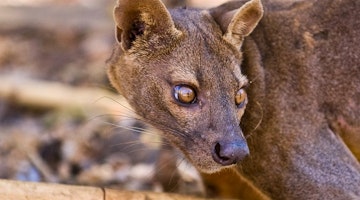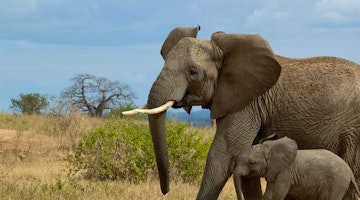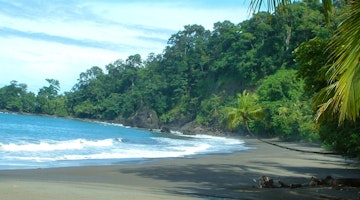With Table Mountain at its heart and ocean all around, Cape Town is one of the most beautiful cities in the world. Wherever you are, the rugged beauty of the mountain dominates the landscape. There is so much to do on a Cape Town holiday - Cape Town has five of the most visited tourist attractions in South Africa: Table Mountain, the Cape Peninsula, Kirstenbosch Botanical Gardens, Robben Island and the Victoria and Alfred Waterfront. There is much to see and do, both in town and in the surroundings.
To the south is the rugged beauty of the Cape Peninsula and Cape Point. In the bay, you can visit Robben Island, now a World Heritage Site. To the north and east of the city are the historic towns of the vineyard region – Stellenbosch, the second oldest town in South Africa and the old Huguenot settlement of Franschhoek. Lunch at one of the famous wine estates, such as Boschendal, and enjoy good food and stunning scenery.
But it is the city itself that is the major attraction. Cape Town is a captivating mix of first and third world, modern living and old world charm. The city is packed with vibrant craft markets and modern shopping malls, art galleries and antique shops, boutiques and restaurants serving fine food and wonderful South African wines.
City Bowl
The City Bowl encompasses central Cape Town, Gardens and, moving up Table Mountain, the Kloof area. Central Cape Town became somewhat run-down, but is now coming up again at the speed of light. Cool new bars, boutiques and boutique hotels seem to open every day on Long Street. You should visit while the street still retains its diversity.
The old colonial buildings house antique shops, second-hand bookshops, craft shops, cafés and delicatessens. Greenmarket Square, site of an interesting flea-market, is also being restored, and the surrounding streets are becoming pedestrian precincts.
Company’s Garden
Company's Garden, a park in the south-west of the city centre, was originally the ‘Company’s Garden’, where fresh vegetables were grown to supply the ships of the Dutch East India Company. It was their need to take on fresh greens and water en route to India that gave rise to the early European settlement of the Cape. Government Avenue bisects the park and you pass the Parliament building and the Office of the President. There are frequent open-air concerts of jazz or African music at the week-end.
St George’s Cathedral
St George’s Cathedral is at the north end of the park. It is known as the People’s Cathedral, because it welcomed people of all races during the apartheid years. In 1989, Archbishop Desmond Tutu led a demonstration of 30,000 people from St George’s and first coined the phrase ‘Rainbow People’ to describe South Africa’s diverse ethnic mix. So we have a special affection for this place here at Rainbow Tours.
If this kind of thing interests you, we suggest you book a ‘Footsteps to Freedom’ city walk. It takes three hours and departs daily (except Sundays) at 10.30 am. Ring 021 426 4260 or check out footstepstofreedom.co.za
At the opposite, southern end of the park is the imposing entrance to that grand colonial beauty, the Mount Nelson Hotel, perhaps no longer the finest hotel in Cape Town, but still occupying the grandest piece of real estate.
If you are after something stylish and comfortable, but less grand than the Mount Nelson, try the Cape Cadogan on Upper Union Street, behind the Mount Nelson.
The Kloof District
As you begin the climb out of City Bowl, onto what is in fact the lower slope of Table Mountain, you come to the Kloof area, which many people consider to be the nicest part of Cape Town. It’s always been a favourite area for Capetonians because it is both near the centre and a neighbourhood of low rise houses, many in Cape Dutch style, with enough room for gardens. The main streets, Kloof Street and Kloof Nek, are alive with cafés, delis, boutiques, interior design emporia and, of course, the ubiquitous estate agents.
People like to stay around the Kloof district because the place is buzzing in the evening and you can walk out to enjoy a meal at one of the many quality restaurants – but do book in season.
The Kloof is an area of guest houses and small boutique hotels and we’ve featured some of our tried and tested favourites: Kensington Place, especially for honeymooners; Table Mountain Lodge, Trevoyan, and Walden House in the Tamboerskloof - but we could recommend quite a few more.
Waterfront To Bantry Bay
he transformation of this historic port area was the foundation for the rebirth of Cape Town in the 1990s and the node point for the growth of South Africa’s tourism sector.
Like Camden Lock in London, or Faneuil Hall in Boston, no one could have foreseen how this area would grow and what an attraction it would become. Its wharves and warehouses are now crammed with a cornucopia of shops and restaurants to suit every taste. There is almost too much to do here.
People often think they should stay at the Waterfront, and there are hotels here, but many people find it rather too busy and too bustling for their holiday base. It’s fine if you are staying at the Cape Grace, an oasis of clam on a private quay, or if you are going to be clubbing into the early hours. Otherwise, you might prefer to be a little further away in a quieter neighbourhood. It’s easy to get to the Waterfront from almost anywhere in Cape Town. Many hotels have shuttle buses, taxis are cheap, and there is as much car parking as you need at the Waterfront.
Leaving the Waterfront to travel north-east along the Atlantic Seaboard, you pass through a series of beachfront areas – Green Point, Sea Point, Bantry Bay, and Clifton - which are all slightly different in style and character. Signal Hill rises up as a backdrop to them all.
Green Point
Green Point is immediately adjacent to the Waterfront and has benefited from the overspill. There is a massive stadium and open space by the sea and, on Sundays, the whole area is given over to a flea market – a mixture of bric-a-brac, crafts and cheap clothing – that is certainly worth a visit. The five-star Radisson Waterfront Hotel is here, on Granger Bay, as well as one of our favourites, Romney Park Luxury Suites hotel, which has good value, spacious apartments with balconies overlooking the sea.
Sea Point
This area, previously characterised by mansion blocks with an aging middle-class population, had become a run down hangout for hawkers, hobos and hookers, until the explosion in house prices forced people to take another look at this prime seafront real estate. The wide promenade has been replanted and reclaimed and joggers and rollerbladers weave in and out of the pensioners walking their dogs. The neglected mansion blocks have been repaired and redecorated, and the flats sell for a small fortune. One block that turned out to have a different destiny was Winchester Mansions, converted into a five-star luxury seafront hotel. If you want to be facing the sea, near the Waterfront, but not right in it, this is the place to stay.
Bantry Bay
Bantry Bay is in the heart of an exclusive residential area stretching along Cape Town’s Atlantic coastline. Once a wealthy suburb on the edge of the city, Bantry Bay is now simply one part of the development that extends beyond Clifton to Camps Bay. The seafront area has been largely rebuilt in the last few years. It features hotels like The President, an established favourite with the English in the period before the Waterfront was built. As one climbs Lion’s Head, you find smaller, more exclusive hotels: Les Cascades is a lovely place to stay, with gardens that plunge down the hillside; and Ellerman House is probably the most exclusive hotel in Cape Town, with stunning views from its rooms and gardens. This is an area of expensive villas precariously hugging the cliff side.
Clifton
Clifton is next along and the first place that has sandy beaches along this stretch of coast. Consequently, it gets hugely crowded in the summer season. The apartment-hotels here - places like The Peninsula and The Ambassador - are used more by South African holidaymakers than foreign tourists. The super-rich have their cliffside villas here. There are four beaches at Clifton and all of them will be pretty well jam-packed at the height of the season. The beaches are numbered, and each beach attracts its own clientele – families, gays, surfers etc.
Camps Bay
Beyond the Waterfront and Green Point, Beach Road takes you along the coast to Sea Point, Bantry Bay and on to fashionable Camps Bay. Camps Bay is a stretch of palm-fringed promenades with a sandy beach, and glorious sunsets, just a ten minute drive from the city centre. Behind, fancy villas climb up Twelve Apostles – some very expensive real estate.
For English families on holiday, this is Cape Town-on-Sea, for the beautiful people, this is the place to see and be seen, a tiny piece of Cannes on the furthest promontory of Africa. Convertible Mercedes and Maseratis whiz up and down and it’s a great place to sit in a seafront pizzeria and watch the world go by.
In Camps Bay, we offer a choice of apartments and apart-hotels, which families enjoy; as well as the very stylish Bay Hotel, and the rather quirky Camps Bay Retreat. The good Camps Bay guest houses are booked up to a year in advance, so we have stopped recommending them. That’s the secret of staying in Camps Bay. For a holiday between November and February, book as early as you possibly can.
Cape Peninsula
Many of Cape Town’s attractions are on the Cape Peninsula, a mountainous spine running south to a point, known as Cape Point, and the Cape of Good Hope, where sailors rounded Africa en route to India and the East.It’s always thrilling to stand at this point, by the lighthouse, and be buffeted by the winds. It isn’t the southernmost point of Africa (that accolade goes to the little-known Agulhas Point) but it certainly feels like it.
A pleasurable way to spend a day is to make the drive around this peninsula, preferably in a clockwise direction, so that you can enjoy the sunset on the Chapman’s Peak Drive and in Hout Bay.
Muizenberg
The first place you come to is the faded beach resort of Muizenberg, where Agatha Christie went surfing 80 years ago and Cecil Rhodes once had a seaside cottage (and where he died in 1902). On this side of the peninsula, known as False Bay, the sea is warmer and calmer; and Cape Town’s best whale-watching spots are on this east side.
Kalk Bay
Next, there is the fishing harbour of Kalk Bay, which dates from the 17th century. ‘Kalk’ was the name given to the lime that was important in building at that time. When the fishing boats come in, there is a lively quayside auction. From here, you can get a boat out to Seal Island, a breeding ground for birds and Cape Fur seals. You may spot some sharks hunting in these waters – Great whites are the seals’ main predator.
Boulders Beach
Continuing your drive, you pass Fish Hoek and its excellent family beach. The next town is Simon’s Town, which became an important naval base for the British and is now the principal South African navy base. There are some museums here, and pretty, well-preserved 18th century streets, but its main attraction is the penguin colony just south of town at Boulders Beach. You can also swim here.
Cape Point Nature Reserve
From Simon’s Town, the road hugs the cliff-side until you enter the Cape Point Nature Reserve, about 70 km south of Cape Town. It occupies the whole southern tip of the peninsula and was proclaimed in 1939 to protect the area from resort developments. You should be able to spot a few wrecks in the waters below Cape Point – the most famous shipwreck was the first, ‘The Flying Dutchman’ in 1680!
Long Beach
Coming out of the nature reserve, you cross to the Atlantic side and come to Long Beach, so-named because it stretches for eight kilometres. The sea is pretty cold and the beach is mostly used for horse-riding and birding. There tidal lagoons are safe for swimming.
There isn’t much accommodation on this side of the peninsula, but Afton Grove is a quiet retreat for nature lovers.
Chapman's Peak
After the flat plain behind Long Beach, the road rises onto the cliffs of Chapman’s Peak, and you have before you a 10-kilometre stretch that is considered one of the world’s most scenic drives. The original road was closed for five years and only re-opened in 1994.
Hout Bay
As you come into Hout Bay, once a fishing village, now a sizeable town, stop at Chapman's Peak Hotel and enjoy a drink, and perhaps a seafood platter, on the verandah.
Getting Around Cape Town
Most of our clients rent a car because the city and sights are quite far apart. Driving and parking are easy compared with the crowded roads of Britain’s cities. You can collect a hire car on arrival or we will deliver it to your hotel. If you don’t wish to drive, there are splendid day tours of the Cape Peninsula and Winelands.
Cape Town has many very comfortable hotels and ownermanaged guesthouses, all offering exceptional value. We like the thriving Kloof area – a neighbourhood of delis, restaurants, bars and designer shops rising out of the city bowl on the way to the mountain.
The transformation of the historic port area was the foundation for the rebirth of Cape Town in the 1990s. Like Camden Lock in London, no one could have foreseen how much this area would grow and what an attraction The Waterfront would become. Its wharves and warehouses are now crammed with a cornucopia of shops and restaurants to suit every taste.
We recommend at least three full days to enjoy this city and its hinterland, but four is better.
Shelley Phillips
Travel Specialist
Where to go in Cape Town
Looking for inspiration?
You'll find expert travel guides, holiday ideas and insider tips now on the Rainbow blog

Top 5 First Time Safari Destinations

10 Strange Animals and Where to Go to See them


Salar De Uyuni - The World's Largest Salt Flat


Top five South Africa Safari lodges

Sustainable Tourism In Corcovado National Park, Costa Rica

Why Choose Us?
Passionate travel experts
- We've been leading wildlife travel since our first South Africa tours over 25 years ago
- Our Travel Specialists have lived in their specialist area for years
- We work with local guides to immerse you deeper in our diverse range of experiences
Personal & tailor-made
- You'll speak to your own expert who'll share their first-hand knowledge
- We'll make your itinerary seamless with 24/7 emergency contact available
- Your Travel Specialist will listen to ensure you have the best chance of seeing the wildlife you love
Responsible by nature
- We take care to actively contribute to the conservation of environments we visit
- For select countries, we make a charitable donation on your behalf when you make your booking
- We've partnered with conservation experts and NGOs to curate responsible tours
For the latest travel advice from the Foreign, Commonwealth and Development Office check www.gov.uk/travelaware












